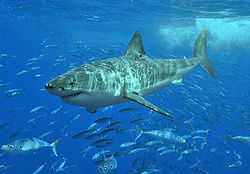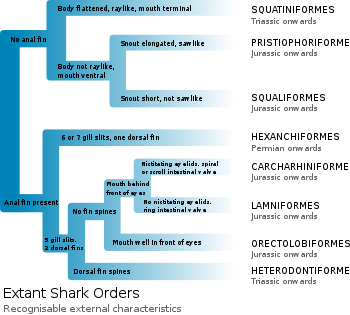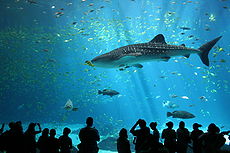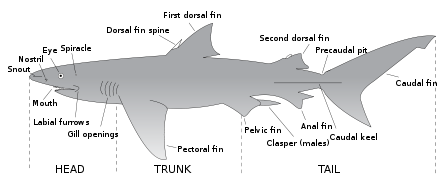
Outline of sharks
Encyclopedia

Shark
Sharks are a type of fish with a full cartilaginous skeleton and a highly streamlined body. The earliest known sharks date from more than 420 million years ago....
s (superorder Selachimorpha) are a type of fish
Fish
Fish are a paraphyletic group of organisms that consist of all gill-bearing aquatic vertebrate animals that lack limbs with digits. Included in this definition are the living hagfish, lampreys, and cartilaginous and bony fish, as well as various extinct related groups...
with a full cartilaginous
Cartilage
Cartilage is a flexible connective tissue found in many areas in the bodies of humans and other animals, including the joints between bones, the rib cage, the ear, the nose, the elbow, the knee, the ankle, the bronchial tubes and the intervertebral discs...
skeleton
Skeleton
The skeleton is the body part that forms the supporting structure of an organism. There are two different skeletal types: the exoskeleton, which is the stable outer shell of an organism, and the endoskeleton, which forms the support structure inside the body.In a figurative sense, skeleton can...
and a highly streamlined
Streamlines, streaklines and pathlines
Fluid flow is characterized by a velocity vector field in three-dimensional space, within the framework of continuum mechanics. Streamlines, streaklines and pathlines are field lines resulting from this vector field description of the flow...
body. The earliest known sharks date from more than 420 million years ago, before the time of the dinosaur
Dinosaur
Dinosaurs are a diverse group of animals of the clade and superorder Dinosauria. They were the dominant terrestrial vertebrates for over 160 million years, from the late Triassic period until the end of the Cretaceous , when the Cretaceous–Paleogene extinction event led to the extinction of...
s.
Since that time, sharks have diversified into more than 440 species, ranging in size from the small dwarf lanternshark
Dwarf lanternshark
The dwarf lanternshark is a little-known species of dogfish shark in the family Etmopteridae and possibly the smallest shark in the world, reaching a maximum known length of . It is known to be present only on the upper continental slopes off Colombia and Venezuela, at a depth of...
, Etmopterus perryi, a deep sea
Deep sea
The deep sea, or deep layer, is the lowest layer in the ocean, existing below the thermocline and above the seabed, at a depth of 1000 fathoms or more. Little or no light penetrates this part of the ocean and most of the organisms that live there rely for subsistence on falling organic matter...
species of only 17 centimetres (6.7 in) in length, to the whale shark
Whale shark
The whale shark, Rhincodon typus, is a slow-moving filter feeding shark, the largest extant fish species. The largest confirmed individual had a length of and a weight of more than , but unconfirmed claims report considerably larger whale sharks...
, Rhincodon typus, the largest fish, which reaches approximately 12 metre and which feeds only on plankton
Plankton
Plankton are any drifting organisms that inhabit the pelagic zone of oceans, seas, or bodies of fresh water. That is, plankton are defined by their ecological niche rather than phylogenetic or taxonomic classification...
, squid
Squid
Squid are cephalopods of the order Teuthida, which comprises around 300 species. Like all other cephalopods, squid have a distinct head, bilateral symmetry, a mantle, and arms. Squid, like cuttlefish, have eight arms arranged in pairs and two, usually longer, tentacles...
, and small fish
Fish
Fish are a paraphyletic group of organisms that consist of all gill-bearing aquatic vertebrate animals that lack limbs with digits. Included in this definition are the living hagfish, lampreys, and cartilaginous and bony fish, as well as various extinct related groups...
by filter feeding. Sharks are found in all seas and are common down to depths of 2000 metres (6,561.7 ft). They generally do not live in freshwater, with a few exceptions such as the bull shark
Bull shark
The bull shark, Carcharhinus leucas, also known as Zambezi shark or unofficially known as Zambi in Africa and Nicaragua shark in Nicaragua, is a shark common worldwide in warm, shallow waters along coasts and in rivers...
and the river shark
River shark
The river sharks are five rare species of shark in the genus Glyphis, although, due to their secretive habits, other species could easily remain undiscovered. Their precise geographic range is uncertain, but the known species are documented in parts of South and Southeast Asia and Australia...
which can live both in seawater and freshwater
Freshwater
Fresh water is naturally occurring water on the Earth's surface in ice sheets, ice caps, glaciers, bogs, ponds, lakes, rivers and streams, and underground as groundwater in aquifers and underground streams. Fresh water is generally characterized by having low concentrations of dissolved salts and...
. They breathe through five to seven gill
Gill
A gill is a respiratory organ found in many aquatic organisms that extracts dissolved oxygen from water, afterward excreting carbon dioxide. The gills of some species such as hermit crabs have adapted to allow respiration on land provided they are kept moist...
slits and have a covering of dermal denticles that protect their skin from damage and parasites. Denticles also improve their fluid dynamics
Fluid dynamics
In physics, fluid dynamics is a sub-discipline of fluid mechanics that deals with fluid flow—the natural science of fluids in motion. It has several subdisciplines itself, including aerodynamics and hydrodynamics...
by maintaining turbulent flow over the animals body, this means that the shark can move faster. They have several sets of replaceable teeth.
Some well-known species such as the great white shark
Great white shark
The great white shark, scientific name Carcharodon carcharias, also known as the great white, white pointer, white shark, or white death, is a large lamniform shark found in coastal surface waters in all major oceans. It is known for its size, with the largest individuals known to have approached...
, tiger shark
Tiger shark
The tiger sharks, Galeocerdo cuvier, is a species of requiem shark and the only member of the genus Galeocerdo. Commonly known as sea tigers, tiger sharks are relatively large macropredators, capable of attaining a length of over . It is found in many tropical and temperate waters, and is...
, and the hammerhead
Hammerhead shark
The hammerhead sharks are a group of sharks in the family Sphyrnidae, so named for the unusual and distinctive structure of their heads, which are flattened and laterally extended into a "hammer" shape called a "cephalofoil". Most hammerhead species are placed in the genus Sphyrna while the...
are apex predator
Apex predator
Apex predators are predators that have no predators of their own, residing at the top of their food chain. Zoologists define predation as the killing and consumption of another organism...
s, at the top of the underwater food chain
Food chain
A food web depicts feeding connections in an ecological community. Ecologists can broadly lump all life forms into one of two categories called trophic levels: 1) the autotrophs, and 2) the heterotrophs...
. Their skills as predators fascinate and frighten humans, even as their survival is under serious threat from fishing and other human activities.
The following outline is provided as an overview of and topical guide to sharks:
Fields
- IchthyologyIchthyologyIchthyology is the branch of zoology devoted to the study of fish. This includes skeletal fish , cartilaginous fish , and jawless fish...
– branch of zoology devoted to fish (including sharks) - MeristicsMeristicsMeristics is an area of ichthyology which relates to counting quantitative features of fish, such as the number of fins or scales. A meristic can be used to describe a particular species of fish, or used to identify an unknown species...
– branch of ichthyology that relates to counting features of fish, such as the number of fins or scales
Biological classification

- Kingdom: AnimalAnimalAnimals are a major group of multicellular, eukaryotic organisms of the kingdom Animalia or Metazoa. Their body plan eventually becomes fixed as they develop, although some undergo a process of metamorphosis later on in their life. Most animals are motile, meaning they can move spontaneously and...
ia - Phylum: Chordata
- Class: ChondrichthyesChondrichthyesChondrichthyes or cartilaginous fishes are jawed fish with paired fins, paired nares, scales, two-chambered hearts, and skeletons made of cartilage rather than bone...
- Subclass: ElasmobranchiiElasmobranchiiElasmobranchii is a subclass of Chondrichthyes or cartilaginous fish, that includes the sharks and the rays and skates .-Evolution:...
- Superorder: Selachimorpha
Types
Subdivisions of the biological classification Selachimorpha include:- CarcharhiniformesCarcharhiniformesThe ground sharks, order Carcharhiniformes, are the largest order of sharks. With over 270 species, carcharhiniforms include a number of common types, such as the blue shark, catsharks, swellsharks, and sandbar shark....
– groundsharks - Heterodontiformes – bullhead sharks
- HexanchiformesHexanchiformesHexanchiformes is the order consisting of the most primitive types of sharks, and numbering just five extant species. Fossil sharks that were apparently very similar to modern sevengill species are known from Jurassic specimens....
– the five extant species of the most primitive types of sharks - LamniformesLamniformesLamniformes is an order of sharks commonly known as mackerel sharks . It includes some of the most familiar species of sharks, such as the great white shark, as well as more unusual representatives, such as the goblin shark and the megamouth shark.Members of the order are distinguished by...
– mackerel sharks - Orectolobiformes – includes carpet sharks, including zebra sharkZebra sharkThe zebra shark is a species of carpet shark and the sole member of the family Stegostomatidae. It is found throughout the tropical Indo-Pacific, frequenting coral reefs and sandy flats to a depth of 62 m...
s, nurse sharkNurse sharkThe nurse shark, Ginglymostoma cirratum, sometimes referred to as the Nur Shark is a shark in the nurse sharks family, the only member of its genus Ginglymostoma...
s, wobbegongWobbegongWobbegong is the common name given to the 12 species of carpet sharks in the family Orectolobidae. They are found in shallow temperate and tropical waters of the western Pacific Ocean and eastern Indian Ocean, chiefly around Australia and Indonesia, although one species occurs as far north as Japan...
s and whale sharkWhale sharkThe whale shark, Rhincodon typus, is a slow-moving filter feeding shark, the largest extant fish species. The largest confirmed individual had a length of and a weight of more than , but unconfirmed claims report considerably larger whale sharks... - Pristiophoriformes – includes sawsharks
- SqualiformesSqualiformesSqualiformes is an order of sharks that includes about 97 species in seven families.Members of the order have two dorsal fins, which usually possess spines, no anal fin or nictitating membrane, and five gill slits. In most other respects, however, they are quite variable in form and size...
– includes gulper sharks, bramble sharks, lantern sharks, rough sharks, sleeper sharks and dogfish sharks - Squatiniformes – angel sharks
- † SymmoriidaSymmoriidaSymmoriida is an extinct order of sharks that contains three families. It was synonymized subjectively with Cladodontida by Lund ; it was corrected as Symmoriiformes by Maisey . It was assigned to Cladoselachii by Goto et al...
- † CladoselachiformesCladoselachiformesCladoselachidae is an extinct family of cartilaginous fishes and among the earliest predecessors of modern sharks. They are the only members of the order Cladoselachiformes and were characterized by having an elongated body with a spine in each of the two dorsal fins.-References:*, Dictionary of...
- † XenacanthidaXenacanthidaXenacanthida is an order of prehistoric sharks that appeared during the Lower Carboniferous period. The family includes the families Xenacanthidae, Diplodoselachidae, and Orthacanthidae. The most notable members of the group are the genera Xenacanthus and Orthacanthus. Some Xenacanthus may have...
(Xenacantiformes) - † Iniopterygia
- † EugeneodontidaEugeneodontidaEugeneodontida is an extinct and poorly known order of bizarre sharks. They possessed a unique "tooth-whorl" on the symphysis of the lower jaw as well as pectoral fins supported by long radials. The palatoquadrate was either fused to the skull or reduced...
- † HybodontiformesHybodontiformesHybodontiformes was an order of sharks, they were characterised by possessing 1-2 pairs of hooked protrusions on their heads.-External links:* http://www.palaeos.com/Vertebrates/Units/070Chondrichthyes/070.600.html#Hybodontiformes...
Behavior

- PredationPredationIn ecology, predation describes a biological interaction where a predator feeds on its prey . Predators may or may not kill their prey prior to feeding on them, but the act of predation always results in the death of its prey and the eventual absorption of the prey's tissue through consumption...
- Apex predatorApex predatorApex predators are predators that have no predators of their own, residing at the top of their food chain. Zoologists define predation as the killing and consumption of another organism...
- Shark threat displayShark threat displayShark threat display, a type of agonistic display, is a behaviour observed in some sharks when they feel threatened or protective. It consists of a contorting of the body into a series of "ritualized" postures coupled with an exaggerated swimming style...
– Behaviour shown by some sharks when threatened - Spy hopping – Raising the head out of the water
Attacks
- International Shark Attack FileInternational Shark Attack FileThe International Shark Attack File is a global database of shark attacks. It began as an attempt to catalogue shark attacks on servicemen during World War II. The Office of Naval Research funded it from 1958 until 1968. During that time a panel of shark experts developed a standard system for...
- List of fatal, unprovoked shark attacks in the United States
- Jersey Shore shark attacks of 1916Jersey Shore Shark Attacks of 1916The Jersey Shore shark attacks of 1916 were a series of shark attacks along the coast of New Jersey between July 1 and July 12, 1916, in which four people were killed and one injured. Since 1916, scholars have debated which shark species was responsible and the number of animals involved, with the...
– series of shark attacks along the coast of New Jersey between July 1 and July 12, 1916 - Summer of the SharkSummer of the SharkThe Summer of the Shark refers to the coverage of shark attacks by American news media in the summer of 2001. The sensationalist coverage of shark attacks began in early July following the Fourth of July weekend shark attack on 8-year-old Jessie Arbogast, and continued almost unabated—despite no...
– the name given to the summer of 2001 by American media outlets capitalizing on a bull shark attack and subsequent shark attacks
Range
- Bodies of water in which sharks can be found include:
- SeaSeaA sea generally refers to a large body of salt water, but the term is used in other contexts as well. Most commonly, it means a large expanse of saline water connected with an ocean, and is commonly used as a synonym for ocean...
s: all - FreshwaterFreshwaterFresh water is naturally occurring water on the Earth's surface in ice sheets, ice caps, glaciers, bogs, ponds, lakes, rivers and streams, and underground as groundwater in aquifers and underground streams. Fresh water is generally characterized by having low concentrations of dissolved salts and...
– some species of shark can live both in seawater and freshwater, and include:- Bull shark
- River sharkRiver sharkThe river sharks are five rare species of shark in the genus Glyphis, although, due to their secretive habits, other species could easily remain undiscovered. Their precise geographic range is uncertain, but the known species are documented in parts of South and Southeast Asia and Australia...
- Sandbar sharkSandbar sharkThe sandbar shark, Carcharhinus plumbeus, is a species of requiem shark, family Carcharhinidae, native to the Atlantic Ocean and the Indo-Pacific. It is distinguishable by its very high first dorsal fin and inter-dorsal ridge....
- Sea
- Depths: from the surface down to depths of 2000 metres (6,561.7 ft).

Habitats
- White Shark CafeWhite Shark CafeThe White Shark Café is a remote mid-Pacific Ocean area noted as a winter and spring habitat of otherwise coastal great white sharks.The area, halfway between Baja California and Hawaii, received its unofficial name in 2002 from researchers at the Monterey Bay Aquarium Research Institute who were...
– remote mid-Pacific Ocean area noted as a winter and spring habitat of otherwise coastal great white sharks
In captivity
- Shark tankShark tankShark tanks may be found in a number of large aquaria.The term “Shark Tank” also can refer to:* HP Pavilion at San Jose, an indoor arena in California* Shark Tank...
- Shark tunnelShark tunnelA shark tunnel is an underwater tunnel that passes through an aquarium typically with sharks and related aquatic life.They are usually made of thick acrylic glass....
– underwater tunnel that passes through an aquarium that keeps sharks
Anatomy

- Physical characteristics of sharksPhysical characteristics of sharksThe physical characteristics of sharks are different from those of bony and many other kinds of fish, but the large number of species and the diversity of shark habitats means that there are many variations on the "typical" shark body.- Respiration :...
– shark skeleton, respiration and skin- Dermal denticle – small outgrowths which cover the skin of sharks
- Ampullae of LorenziniAmpullae of LorenziniThe ampullae of Lorenzini are special sensing organs called electroreceptors, forming a network of jelly-filled pores. They are mostly discussed as being found in cartilaginous fishes ; however, they are also reported to be found in Chondrostei such as Reedfish and sturgeon. Lungfish have also been...
– sensing organ that helps sharks and fish to sense electric fields - ElectroreceptionElectroreceptionElectroreception is the biological ability to perceive natural electrical stimuli. It has been observed only in aquatic or amphibious animals, since water is a much better conductor than air. Electroreception is used in electrolocation and for electrocommunication.- Overview :Electroreception is...
– the biological ability to perceive electrical impulses (see also Ampullae of Lorenzini) - Lateral lineLateral lineThe lateral line is a sense organ in aquatic organisms , used to detect movement and vibration in the surrounding water. Lateral lines are usually visible as faint lines running lengthwise down each side, from the vicinity of the gill covers to the base of the tail...
– sense organ that detects movement and vibration in the surrounding water - Shark cartilageShark cartilageShark cartilage is a dietary supplement made from the dried and powdered cartilage of a shark; that is, from the tough material that composes a shark's skeleton. Shark cartilage is claimed to combat and/or prevent a variety of illnesses, most notably cancer. It is often marketed under the names...
– material that a sharks' skeleton is composed of - Shark teeth
- SpiracleSpiracleSpiracles are openings on the surface of some animals that usually lead to respiratory systems.-Vertebrates:The spiracle is a small hole behind each eye that opens to the mouth in some fishes. In the primitive jawless fish the first gill opening immediately behind the mouth is essentially similar...
– pumps water across gills - Clasper – the anatomical structure that male sharks use for mating
- Fish anatomyFish anatomyFish anatomy is primarily governed by the physical characteristics of water, which is much denser than air, holds a relatively small amount of dissolved oxygen, and absorbs more light than air does.- Body :...
– generic description of fish anatomy
Protective equipment

- Drum linesDrum linesA drum line is an aquatic device used to reduce the amount of shark attacks in popular beaches by capturing the shark on the drum line's hook. While most drum lines are used in addition to the shark net, it has been proven that the drum line is more effective at catching the three more deadly sharks...
- Shark netShark netA shark net is a submerged net placed around beaches to reduce shark attacks on swimmers.Shark nets do not offer complete protection but work on the principle of "fewer sharks, fewer attacks". They reduce occurrence via shark mortality. Reducing the local shark populations is believed to reduce the...
– submerged net placed around beaches to reduce shark attacks on swimmers - Shark proof cageShark proof cageA shark proof cage is an extremely strong metal cage used by a SCUBA diver to safely examine dangerous types of sharks up close, such as the Great White shark or bull shark. Shark proof cages are built to withstand being rammed by large, powerful sharks. The cages provide a visual and tactile...
– cage from which a SCUBA diver can examine sharks more safely - Shark repellentShark repellentA shark repellent is any method of driving sharks away from an area, object, person, or animal. Shark repellents are one category of animal repellents.-Overview:Shark repellents have been of interest to human beings for many years, for a number of reasons...
– method of driving sharks from an area, object, person, or animal- Magnetic shark repellentMagnetic shark repellentMagnetic shark repellents utilize permanent magnets, which exploit the sensitivity of the Ampullae of Lorenzini in sharks and rays . This organ is not found on bony fishes , therefore, this type of shark repellent is selective to sharks and rays...
– use of permanent magnet to repel sharks - Protective Oceanic DeviceProtective Oceanic DeviceThe Protective Oceanic Device is a portable device that emits an electromagnetic field around a person protecting against sharks. The POD was developed by Natal Sharks Board, and was the first successful electronic shark repellent for scuba divers....
– first successful electronic shark repellent
- Magnetic shark repellent
- Shark suitShark suitA shark suit is a body-cover suit made of chainmail worn sometimes by scuba divers to protect against shark bite. While the wearer will feel the full pressure of the bite, the suit prevents any concentration of force from the shark's teeth and effectively prevents any true damage to the wearer's...
Fishing
- Drivers of the shark trade
- Land-based shark fishing – fishing for sharks from land such as a beachBeachA beach is a geological landform along the shoreline of an ocean, sea, lake or river. It usually consists of loose particles which are often composed of rock, such as sand, gravel, shingle, pebbles or cobblestones...
, shoreline, jettyJettyA jetty is any of a variety of structures used in river, dock, and maritime works that are generally carried out in pairs from river banks, or in continuation of river channels at their outlets into deep water; or out into docks, and outside their entrances; or for forming basins along the...
, pierPierA pier is a raised structure, including bridge and building supports and walkways, over water, typically supported by widely spread piles or pillars...
, or bridgeBridgeA bridge is a structure built to span physical obstacles such as a body of water, valley, or road, for the purpose of providing passage over the obstacle... - Shark finningShark finningShark finning refers to the removal and retention of shark fins and the discarding of the rest of the fish. Shark finning takes place at sea so the fishers only have to transport the fins.Shark finning is widespread, and largely unmanaged and unmonitored...
–the removal of shark fins for commercial purposes
Conservation

- 1992 Cageless shark-diving expedition1992 Cageless shark-diving expeditionThe 1992 cageless shark-diving expedition was the world's first cageless dive with great white sharks. It contributed to changing public opinions about the supposed ferocity of these animals.-History:...
– 1st publicized cageless dive with great white sharks which contributed to changing public opinions about the supposed "killing machine" - Shark AllianceShark AllianceThe Shark Alliance is a global not-for-profit coalition founded in 2006 of non-governmental organizations dedicated to restoring and conserving shark populations by improving shark conservation policies....
– coalition of non-governmental organizations dedicated to restoring and conserving shark populations by improving European fishing policy - Shark Conservation ActShark Conservation ActThe Shark Conservation Act of 2010 is a bill passed by the 111th United States Congress that would amend the High Seas Driftnet Fishing Moratorium Protection Act and the Magnuson–Stevens Fishery Conservation and Management Act to improve the conservation of sharks...
– Proposed US law to protect sharks - Shark sanctuaryShark sanctuaryA shark sanctuary is an area that forbids commercial fishing operations from catching any shark. As of 2011, four nations have signed shark sanctuaries into law.-History:...
– Palau's first-ever attempt to prohibit taking sharks within its territorial waters - Shark tourismShark tourismShark tourism is a form of ecotourism rooted in having communities appreciate that local shark species are more valuable alive than dead. Instead of opting for a one time economic benefit of harvesting sharks for their body parts, communities are made to assist interested tourists who may want to...
– form of ecotourism showcasing sharks - Shark TrustShark TrustShark Trust is a charitable organization founded in the UK in 1997"dedicated to promoting the study, management, and conservation of sharks,skates and rays in the UK and internationally."....
– A UK organisation for conservation of sharks
Notable sharks
- Stronsay BeastStronsay BeastThe Stronsay beast was a large, dead carcass or globster that washed ashore on the island of Stronsay , in the Orkney Islands, after a storm on September 25, 1808...
– large, dead creature washed ashore on StronsayStronsayStronsay is an island in Orkney, off the north coast of Scotland. The main village is Whitehall, home to a heritage centre. It is in size, and at its highest point....
, in the Orkney IslandsOrkney IslandsOrkney also known as the Orkney Islands , is an archipelago in northern Scotland, situated north of the coast of Caithness...
, after a storm in 1808, later presumed to be a basking sharkBasking sharkThe basking shark is the second largest living fish, after the whale shark. It is a cosmopolitan migratory species, found in all the world's temperate oceans. It is a slow moving and generally harmless filter feeder and has anatomical adaptations to filter feeding, such as a greatly enlarged...
Notable researchers and people

- Peter BenchleyPeter BenchleyPeter Bradford Benchley was an American author, best known for his novel Jaws and its subsequent film adaptation, the latter co-written by Benchley and directed by Steven Spielberg...
– author of the novel JawsJaws (novel)Jaws is a 1974 novel by Peter Benchley. It tells the story of a great white shark that preys upon a small resort town, and the voyage of three men to kill it....
, later worked for shark conservation - Jacques-Yves CousteauJacques-Yves CousteauJacques-Yves Cousteau was a French naval officer, explorer, ecologist, filmmaker, innovator, scientist, photographer, author and researcher who studied the sea and all forms of life in water...
– FrenchFranceThe French Republic , The French Republic , The French Republic , (commonly known as France , is a unitary semi-presidential republic in Western Europe with several overseas territories and islands located on other continents and in the Indian, Pacific, and Atlantic oceans. Metropolitan France...
naval officer, explorer, ecologist, filmmaker, innovator, scientist, photographer, author and researcher who studied the sea and all forms of life in water including sharks - Eugenie ClarkEugenie ClarkEugenie Clark , popularly known as The Shark Lady, is an American ichthyologist known for her research on poisonous fish of the tropical seas and on the behaviour of sharks.-Academic life:...
–American ichthyologist researching poisonous fish and the behavior of sharks; popularly known as The Shark Lady - Leonard CompagnoLeonard CompagnoLeonard Joseph Victor Compagno is an international authority on shark taxonomy and the author of many scientific papers and books on the subject, best known of which is his 1984 catalogue of shark species produced for the Food and Agriculture Organization of the United Nations.-Career:*Ph.D,...
–international authority on shark taxonomy, best known for 1984 catalog of shark species (FAO) - Ben CroppBen CroppBen Cropp is an Australian former shark hunter and six-time Australian spearfishing champion, having retired from that trade in 1962 to pursue oceanic documentary filmmaking and conservation efforts...
–AustraliaAustraliaAustralia , officially the Commonwealth of Australia, is a country in the Southern Hemisphere comprising the mainland of the Australian continent, the island of Tasmania, and numerous smaller islands in the Indian and Pacific Oceans. It is the world's sixth-largest country by total area...
n former shark hunter, who stopped in 1962 to produced some 150 wildlife documentaries - Richard EllisRichard Ellis (biologist)Richard Ellis is an American marine biologist, author, and illustrator. He is a research associate in the American Museum of Natural History's division of paleontology, special adviser to the American Cetacean Society, and a member of the Explorers Club. He was U.S...
– American marine biologist, author, and illustrator. - Rodney Fox – South Australian film maker, conservationist, survivor of great white shark attack and one of the world's foremost authorities on them
- Andre HartmanAndre HartmanAndre Hartman is a South African diving guide best known for his work with great white sharks. In a Discovery Channel documentary known as "Great White Sharks: Uncaged" he is filmed free-diving unprotected with several great white sharks....
– South AfricaSouth AfricaThe Republic of South Africa is a country in southern Africa. Located at the southern tip of Africa, it is divided into nine provinces, with of coastline on the Atlantic and Indian oceans...
n diving guide best known for free-diving unprotected with great white sharks - Hans HassHans HassHans Hass is a diving pioneer known mainly for his documentaries about sharks, the energon theory, and his commitment, later in life, to the protection of the environment. He was born in Vienna, Austria.-Early years:...
– diving pioneer, known for shark documentaries - Mike RutzenMike RutzenMike Rutzen is an expert on the great white shark and an outspoken champion of shark conservation. His fame spread due to the images of his free diving exploits swimming with the animals without a cage. Mike has spent more time swimming cage-less with great whites than anyone else...
– great white shark expert and outspoken champion of shark conservation; known for free diving unprotected with great white sharks - Ron & Valerie TaylorRon & Valerie TaylorRon Taylor and Valerie Taylor are prominent Australian shark and underwater experts. Their expertise has been called upon for films such as Jaws, Orca and Sky Pirates....
– ex-spearfishing champions who switched from killing to filming underwater documentaries
See also
- List of ichthyology terms
- List of megamouth shark specimens and sightings
- List of prehistoric cartilaginous fish
- List of Red Sea sharks

